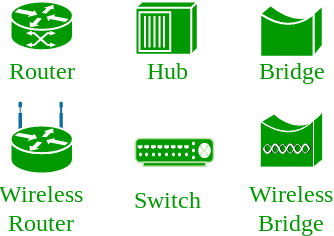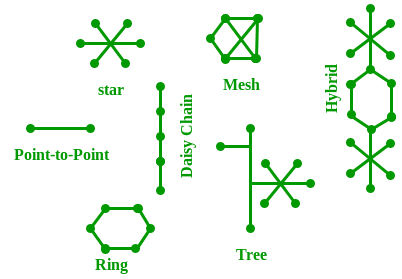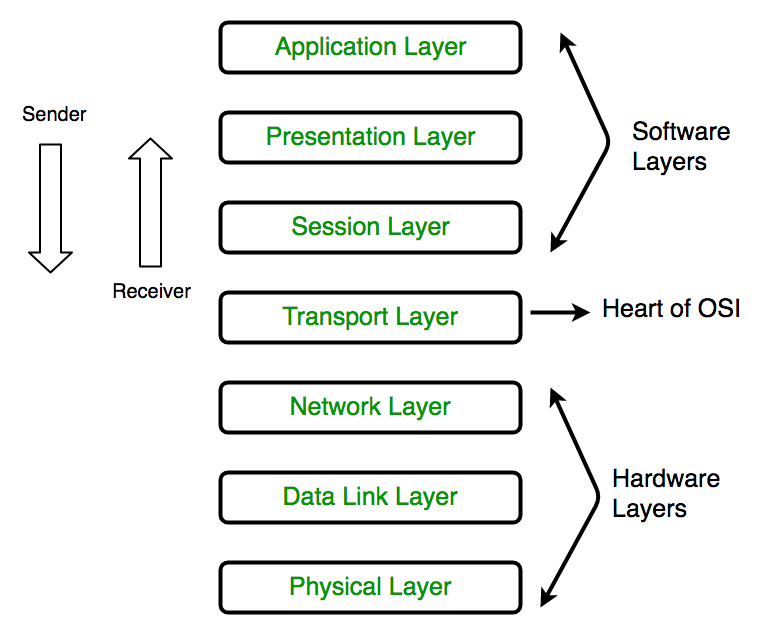Types of Network Topology
The arrangement of a network that comprises nodes and connecting lines via sender and receiver is referred to as network topology. The various network topologies are:
Mesh Topology:
In a mesh topology, every device is connected to another device via a particular channel. In Mesh Topology, the protocols used are AHCP (Ad Hoc Configuration Protocols), DHCP (Dynamic Host Configuration Protocol), etc.

Figure 1: Every device is connected with another via dedicated channels. These channels are known as links.
- Suppose, the N number of devices are connected with each other in a mesh topology, the total number of ports that are required by each device is N-1. In Figure 1, there are 5 devices connected to each other, hence the total number of ports required by each device is 4. Total number of ports required=N*(N-1).
- Suppose, N number of devices are connected with each other in a mesh topology, then the total number of dedicated links required to connect them is NC2 i.e. N(N-1)/2. In Figure 1, there are 5 devices connected to each other, hence the total number of links required is 5*4/2 = 10.
Advantages of this topology:
- It is robust.
- The fault is diagnosed easily. Data is reliable because data is transferred among the devices through dedicated channels or links.
- Provides security and privacy.
Problems with this topology:
- Installation and configuration are difficult.
- The cost of cables is high as bulk wiring is required, hence suitable for less number of devices.
- The cost of maintenance is high.
Star Topology:
In star topology, all the devices are connected to a single hub through a cable. This hub is the central node and all other nodes are connected to the central node. The hub can be passive in nature i.e., not an intelligent hub such as broadcasting devices, at the same time the hub can be intelligent known as an active hub. Active hubs have repeaters in them. In Star Topology, many popular Ethernet LAN protocols are used as CD(Collision Detection), CSMA (Carrier Sense Multiple Access), etc.

Figure 2: A star topology having four systems connected to a single point of connection i.e. hub.
Advantages of this topology:
- If N devices are connected to each other in a star topology, then the number of cables required to connect them is N. So, it is easy to set up.
- Each device requires only 1 port i.e. to connect to the hub, therefore the total number of ports required is N.
- It is Robust. If one link fails only that link will affect and not other than that.
- Easy to fault identification and fault isolation.
Problems with this topology:
- If the concentrator (hub) on which the whole topology relies fails, the whole system will crash down.
- The cost of installation is high.
- Performance is based on the single concentrator i.e. hub.
Bus Topology:
Bus topology is a network type in which every computer and network device is connected to a single cable. It transmits the data from one end to another in a single direction. No bi-directional feature is in bus topology. It is a multi-point connection and a non-robust topology because if the backbone fails the topology crashes. In Bus Topology, various MAC (Media Access Control) protocols are followed by LAN ethernet connections like TDMA, Pure Aloha, CDMA, Slotted Aloha, etc.

Figure 3: A bus topology with shared backbone cable. The nodes are connected to the channel via drop lines.
Advantages of this topology:
- If N devices are connected to each other in a bus topology, then the number of cables required to connect them is 1, which is known as backbone cable, and N drop lines are required.
- The cost of the cable is less compared to other topologies, but it is used to build small networks.
Problems with this topology:
- If the common cable fails, then the whole system will crash down.
- If the network traffic is heavy, it increases collisions in the network. To avoid this, various protocols are used in the MAC layer known as Pure Aloha, Slotted Aloha, CSMA/CD, etc.
- Security is very low.
Ring Topology:
In this topology, it forms a ring connecting devices with exactly two neighboring devices.
A number of repeaters are used for Ring topology with a large number of nodes, because if someone wants to send some data to the last node in the ring topology with 100 nodes, then the data will have to pass through 99 nodes to reach the 100th node. Hence to prevent data loss repeaters are used in the network.
The transmission is unidirectional, but it can be made bidirectional by having 2 connections between each Network Node, it is called Dual Ring Topology. In-Ring Topology, the Token Ring Passing protocol is used by the workstations to transmit the data.

Figure 4: A ring topology comprises 4 stations connected with each forming a ring.
The following operations take place in ring topology are :
- One station is known as a monitor station which takes all the responsibility to perform the operations.
- To transmit the data, the station has to hold the token. After the transmission is done, the token is to be released for other stations to use.
- When no station is transmitting the data, then the token will circulate in the ring.
- There are two types of token release techniques: Early token release releases the token just after transmitting the data and Delay token release releases the token after the acknowledgment is received from the receiver.
Advantages of this topology:
- The possibility of collision is minimum in this type of topology.
- Cheap to install and expand.
Problems with this topology:
- Troubleshooting is difficult in this topology.
- The addition of stations in between or removal of stations can disturb the whole topology.
- Less secure.
Tree Topology :
This topology is the variation of the Star topology. This topology has a hierarchical flow of data. In Tree Topology, SAC (Standard Automatic Configuration ) protocols like DHCP and SAC are used.

Figure 5: In this, the various secondary hubs are connected to the central hub which contains the repeater. This data flow from top to bottom i.e. from the central hub to the secondary and then to the devices or from bottom to top i.e. devices to the secondary hub and then to the central hub. It is a multi-point connection and a non-robust topology because if the backbone fails the topology crashes.
Advantages of this topology :
- It allows more devices to be attached to a single central hub thus it decreases the distance that is traveled by the signal to come to the devices.
- It allows the network to get isolated and also prioritize from different computers.
Problems with this topology :
- If the central hub gets fails the entire system fails.
- The cost is high because of cabling.
Hybrid Topology :
This topology technology is the combination of all the various types of topologies we have studied above. It is used when the nodes are free to take any form. It means these can be individuals such as Ring or Star topology or can be a combination of various types of topologies seen above. Each individual topology uses the protocol that has been discussed earlier.

Hybrid Topology
Figure 6: The above figure shows the structure of the Hybrid topology. As seen it contains a combination of all different types of networks.










